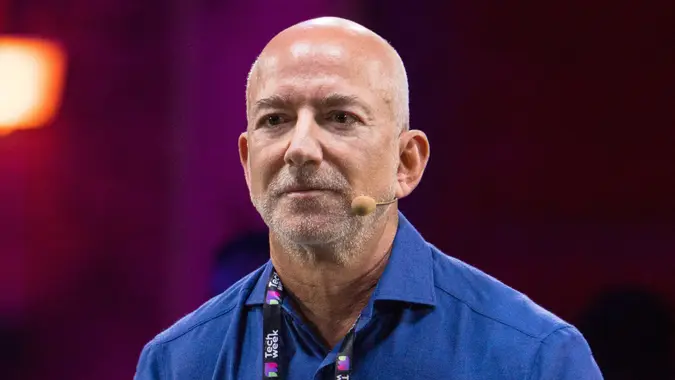4 Money Myths Debunked

Commitment to Our Readers
GOBankingRates' editorial team is committed to bringing you unbiased reviews and information. We use data-driven methodologies to evaluate financial products and services - our reviews and ratings are not influenced by advertisers. You can read more about our editorial guidelines and our products and services review methodology.

20 Years
Helping You Live Richer

Reviewed
by Experts

Trusted by
Millions of Readers
You see them all over social media — financial memes or “facts” floating around that people swear by. But is there any truth to them?
GOBankingRates spoke with Andrew Latham, certified financial planner and managing editor with SuperMoney, and Stoy Hall, certified financial planner and CEO of Black Mammoth, to unveil which money myths actually hold some truth to them. Below, they weigh in on which hype you should believe.
Also see some stock market myths that are not true.
Myth: Passive Investing Yields a Higher Return
“The myth that passive investing, such as in low-cost index funds, generally provides a higher return on investment (ROI) than actively managed funds is indeed true,” Latham said.
Latham went on to explain that passive investments benefit from lower expense ratios, directly enhancing net returns. “For example, Vanguard’s research indicates that investors can save between 41 and 60 basis points annually by choosing cost-effective funds, leading to better long-term performance,” he added.
While passive investing often leads to higher ROI, Latham added that financial advisors still provide essential value through strategic financial planning and emotional support, which ultimate benefits investors’ long-term financial success.
Myth: Living Paycheck to Paycheck Is a Bad Thing
Contrary to popular belief, Hall said living paycheck to paycheck can be a beneficial financial strategy — but only in very specific contexts.
“The key is to reframe what ‘paycheck to paycheck’ means,” he said. “It’s not about struggling to make ends meet, but rather about allocating every dollar you earn to a specific purpose.”
He said this approach ensures that your money is working for you efficiently. The first step is to better allocate your savings.
“Immediately put 10% of your income into savings,” he explained. “This creates a cushion for emergencies and future investments. By prioritizing savings first, you ensure that you are building a financial safety net and preparing for future opportunities.”
When designing your approach to savings, you should next prepare to reserve about 40% of your income to the essential expenses of your household, such as groceries, bills and children’s needs.
However, all work and no joy can make for a dull life, so Hall encouraged you to make sure you sock some of your paycheck away for pleasure and other fun activities.
“Designate 10% for travel, hobbies or other activities that bring you joy,” he said. “This ensures that you are not depriving yourself of life’s pleasures, which can lead to a more balanced and satisfying lifestyle.”
The trick to “living paycheck to paycheck” is ensuring that every dollar has a purpose. Instead of being financially irresponsible, this approach means you’re being disciplined and strategic about your spending.
Myth: Emotions Should Not Determine Money Decisions
“Many people believe that emotional decisions around money lead to impulsive and unwise spending,” Hall noted. “However, understanding the emotions associated with your finances can lead to better financial decisions.”
Having awareness around your emotions when it comes to money is key to understanding the financial decisions you ultimately make. Take note of how different financial decisions make you feel: Does saving stress you out? Are you at your happiest when you’re spending money on certain activities. Understanding your emotions around certain financial decisions can help you make decisions that align with your values and life goals.
Myth: Investing in Yourself Is Not a Sound Financial Choice
While traditional investments such as stocks and real estate are often touted for their returns, Hall said investing in yourself can provide unparalleled benefits.
“This includes mental and physical health investments that contribute to your overall well-being,” he said. “Spend on therapy or activities that reduce stress and improve mental clarity. This leads to a happier, more productive life. Mental health investments can include counseling, meditation classes, or even stress-relief activities like hobbies and travel.
“Invest in good nutrition and a gym membership. Healthy eating and regular exercise boost your energy levels and productivity. This might also include spending on high-quality, nutrient-dense foods, fitness equipment, or personal training sessions.”
Hall also recommends investing in personal growth.
“Take courses, attend workshops or pursue hobbies that enhance your skills and happiness,” he explained. “Whether it’s learning a new language, developing a professional skill, or engaging in creative pursuits, personal growth investments pay off in increased confidence and capability.
“When you are joyful and happy, you have higher energy. When you have higher energy, you do more things. When you do more things, you work harder and make more money. By prioritizing your well-being, you set the stage for greater productivity and financial success.”
 Written by
Written by  Edited by
Edited by 

























